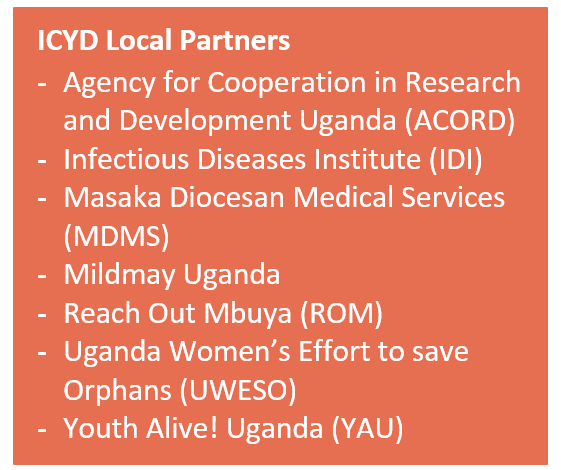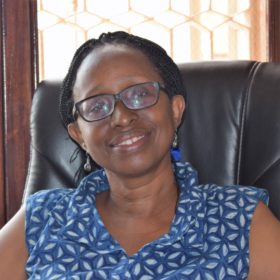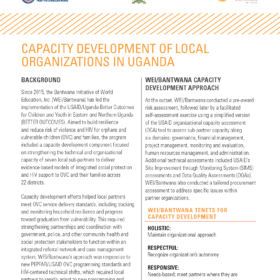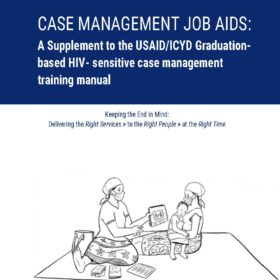Widespread poverty, harmful cultural norms, high rates of abuse, and limited access to timely health and social protection services compromise the health and safety of Uganda’s youth. But for those children and adolescents living with HIV, the situation is even more dire — and has been compounded by the economic and psychosocial stresses of the COVID pandemic, as well as by growing climate and food insecurity. Across the country, HIV treatment outcomes among young people lag behind adults and protracted school closures have contributed to higher rates of abuse and teen pregnancy, deepening the vulnerability of girls and women to sexual violence and HIV transmission risk.
Through the USAID-funded Integrated Child and Youth Development (ICYD) Activity, which works at scale to mitigate the impacts of violence and HIV, the Bantwana Initiative is driving programming that serves thousands of orphans and vulnerable children. As the OVC technical lead — in partnership with the prime contractor Education Development Center (EDC) — our interventions support the achievement of ICYD’s three mutually reinforcing goals:
- Children and youth have improved learning outcomes
- Children and youth are protected, safe, and healthy in their homes, communities, and learning environments.
- Youth practice positive behaviors and make informed decisions about their lives and relationships.
Through targeted, data-driven technical assistance, we support seven local partners to deliver a tailored package of HIV and gender-based violence (GBV) prevention and response services to nearly a quarter of a million Ugandans. Applying a clinic-community referral network and case management approach across 44 districts, we are reaching 235,000 children and caregivers — including 28,000 children and adolescents living with HIV (C/ALHIV).
We help partners’ upskill Uganda’s community child protection workforce as the front line HIV and GBV service providers:
- On the prevention side, our partners deliver evidence-based prevention programming to 9-14 year olds in community safe spaces and link children needing additional services. We extend from communities to schools through support for the implementation of the GOU’s Early Warning System to prevent school drop out by linking children at risk to case management.
- On the response side, our partners coordinate closely with clinical services providers to support treatment continuity and resilience outcomes at the community level for children and adolescents living with HIV.
We extend the continuity of treatment and care beyond the clinic to community level within a locally responsive clinic-community referral network and case management approach. Together with clinic partners, ICYD social workers and parasocial workers (PSWs) enroll children, develop care plans, coordinate service delivery, and conduct joint home visits to assess and address barriers to treatment outcomes and ensure children access services across the continuum of care.
Government Systems Strengthening & Capacity Development for Local Organizations
Bantwana complements its service delivery technical assistance (TA) role with capacity development and systems strengthening to deepen locally-led development and government ownership of Uganda’s HIV and child protection response.
At government level, we support the Ministry of Gender, Labor and Social Development (MGSLD) to roll out the National Child Policy across multiple line ministries, including the Ministry of Health and Ministry of Education, at national and district level, thus cementing the building blocks of the national case management system This involves building skills in HIV and GBV prevention and response among district officers, improving supervision of local partners and community structures, and establishing multi-sectoral Child Welfare Committees for joint planning and resource leverage across ministries. We enhance coordination and timely response on reported abuse cases between Uganda’s 116 National Child Help Line, District Action Centers, and the community workforce through our proven Closed User Group in-service phone network.
Our capacity development of local partners focuses on strengthening organizational, financial, and M&E systems and building technical capacity of staff to foster strong government, clinic, and school linkages and operate within a referral network and case management system. Four of our seven local partners are on track to transition to direct USG funding in October 2022. We will continue to improve capacity and programming quality for all seven partners following transition to direct awards.
Key Results (2022):
 Strengthened the capacity of more than 3,000 parasocial workers and social workers to coordinate and deliver health, livelihoods, and social protection services with clinic partners to 235,000 children and caregivers.
Strengthened the capacity of more than 3,000 parasocial workers and social workers to coordinate and deliver health, livelihoods, and social protection services with clinic partners to 235,000 children and caregivers.
Ensured continuity of treatment and monitored resilience, adherence, retention and other HIV treatment outcomes for 22,000 (C/ALHIV) at community level, increasing their viral load suppression from 79% to 90% in one year
 Layered parenting, early childhood development, HIV and GBV prevention curricula and nutrition education on economic strengthen interventions to 50,000 OVC and caregivers to build knowledge, strengthen family coping skills, , and cooperation to improve safety, stability, health, and learning for all children.
Layered parenting, early childhood development, HIV and GBV prevention curricula and nutrition education on economic strengthen interventions to 50,000 OVC and caregivers to build knowledge, strengthen family coping skills, , and cooperation to improve safety, stability, health, and learning for all children.
Built the agency, confidence and skills of 29,712 girls and boys (ages 10-14) to prevent and report violence, with a focus on sexual violence prevention—especially for girls—and layered prevention supports on children’s home study groups and through case management to build COVID coping skills and support children’s return to school.

Delivered immunization, food and nutrition education insecticide nets, and livelihoods support to more than 11,000 children and their families through community and private sector partnerships
Supported the government to disseminate the National Child Plan in 18 districts and establish 45 Child Welfare Committees at district level and below
Trained 30 national Child Helpline staff to use data to strengthen targeted follow up on reported cases in GBV ‘hotspots’ and successfully advocate for additional staff to respond to 116 calls.


 Strengthened the capacity of more than 3,000 parasocial workers and social workers to coordinate and deliver health, livelihoods, and social protection services with clinic partners to 235,000 children and caregivers.
Strengthened the capacity of more than 3,000 parasocial workers and social workers to coordinate and deliver health, livelihoods, and social protection services with clinic partners to 235,000 children and caregivers. Layered parenting, early childhood development, HIV and GBV prevention curricula and nutrition education on economic strengthen interventions to 50,000 OVC and caregivers to build knowledge, strengthen family coping skills, , and cooperation to improve safety, stability, health, and learning for all children.
Layered parenting, early childhood development, HIV and GBV prevention curricula and nutrition education on economic strengthen interventions to 50,000 OVC and caregivers to build knowledge, strengthen family coping skills, , and cooperation to improve safety, stability, health, and learning for all children.





